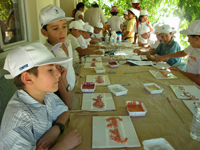TEMPER PROJECT
Louise Doughty
The Çatalhöyük Research Project continued its involvement in the TEMPER (‘Training, Education, Management and Prehistory in the Mediterranean’) project as it entered its second year. This project is a Mediterranean-wide heritage project funded by the European Union which involves five prehistoric sites in four Mediterranean countries: Çatalhöyük in Turkey; Paliambela Kolindros in Greece; Ubeidiya and Sha’ar Hagolan in Israel; and Kordin III on Malta. The project has three key strands: the development of integrated site-management plans; the development of educational programmes; and the implementation of a training programme on heritage management.
Temper Developments in 2003
Much of 2002 was taken up with research and development. Each partner conducted research into the current state of heritage management and education in their country. For the management planning, international examples of best practice were studied and a ‘framework’ was created to guide the development of each integrated site management plan. On the educational side of the project, partners researched the current levels of archaeological educational provision, particularly involving prehistoric sites. As expected by the Temper team, this was low or non-existent in each country. The Temper educational programmes will address this specific gap in provision.
During the summer of 2003, educational programmes have been devised and piloted at Çatalhöyük, Paliambela and Kordin III. Management plans have been developed for these sites plus the two Israeli sites of Ubeidiya and Sha’ar Hagolan. In addition the project website (www. temper-euromed.org) has been extensively re-designed and expanded. As well as providing information on Temper aims and objectives, it now includes background information on all the sites involved and is regularly updated with the project newsletter, research results and information about forthcoming events. The Temper Educational Programme at Çatal¬höyük involved children aged between eight and twelve years old from two schools in Istanbul and two schools from Kücükköy and Çümra. Research and consultation with teachers found that there was a general lack of resources on archaeology and prehistory, and that this was required to be able put Çatalhöyük into context. The pilot programme devised included two-hour classroom sessions on archaeology conducted by Gulay Sert with accompanying text books on archaeology and Çatalhöyük, a visit to the prehistory galleries of a museum (Istanbul Archaeology Museum and the Konya Museum) and culminated with a visit to Çatalhöyük during the excavation season. On 16 August 2003 over 70 children visited the site and took part in a number of different educational activities organized by the History Foundation. These included excavation of Mellaart’s spoil heap (Fig. 33), site tours with archaeologists, modelling figurines in clay (Fig. 34), and reproducing some of Çatalhöyük’s famous wall paintings (Fig. 8).

Figure 33. Children ‘excavating’ Mellaart’s spoil heap as part of the Temper educational programme

Figure 34. Clay figurine made as part of the Temper educational programme
 |
 |
 |
Figure 8. Temper education programme at Çatalhöyük (see also p. 21)